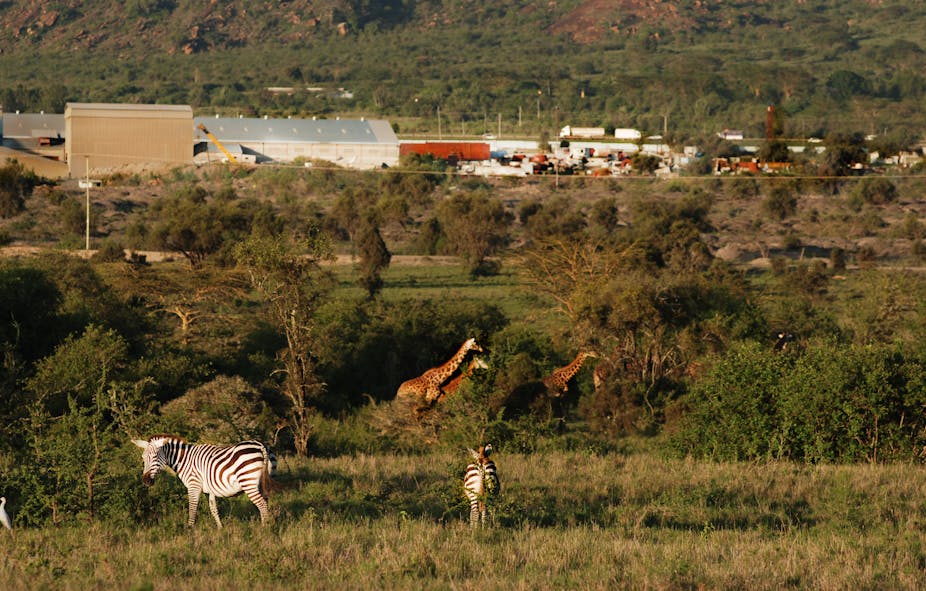The Athi-Kaputiei ecosystem covers about 2,200 square kilometres of Kenya’s Kajiado County, south of Nairobi. It is also home to Nairobi National Park – the world’s only game reserve within a major city.
The ecosystem – where all living organisms interact with each other and their environment – has experienced some dramatic changes since the late 19th century. The accounts of early writers paint a picture of a spectacular ecosystem teeming with diverse resident and migratory wildlife. Records describe abundant wildebeest that migrated seasonally with other wildlife species, livestock and pastoralists.
Today this is no longer the case. In a recently published study my colleagues and I examined the impact of land fragmentation in the Athi-Kaputiei ecosystem between 1977 and 2014.
Our study shows that the area has experienced major land use and tenure changes. This urbanisation and development has put the ecosystem in distress. It has fragmented the landscape which has reduced the ability of animals to migrate as they used to. The result is that their numbers have plummeted.
The case of Athi-Kaputiei
Athi-Kaputiei is close to Nairobi where undeveloped land is exceedingly scarce and expensive. This has made it a powerful magnet for people seeking cheap land.
The urban centres there have expanded rapidly, as has the number of residents. In addition, industries and businesses bought land in the plains that were once a critical habitat for animals. The expansion of the road network also accelerated fragmentation of the landscape. And the privatisation of formerly communally owned land resulted in fences being put up along the major roads and around individual land parcels.
These changes have led to massive declines in the numbers and ranges of wildlife herds.
The main causes of this have been constraints on access to pasture and drinking water in rivers and dams. In addition, many of the traditional migratory pathways have been blocked by fences, settlements, roads and other infrastructure. Only a few of the historical migratory pathways along Isinya-Kajiado and Kiserian-Isinya and other parts of the ecosystem are still usable.
This has meant that animals have less access to food. For example wildebeest and zebra are less able to move between Nairobi National Park – the dry season range – and the Athi-Kaputiei Plains, which are their wet season breeding and feeding grounds.
Poachers who hunt wildlife for bushmeat have used these conditions to their advantage. There are reports of widespread illegal killing of wildlife, especially the migratory wildebeest population. Poachers are known to run wildebeest herds into fences and set snares along their lines.
Between 1977 and 2014 the number of Thomson’s gazelles declined by over 70% and impala numbers decreased by more than 86%. Grant’s gazelle, Coke’s hartebeest, eland and giraffe numbers all declined by at least 64% - 84%.
Wildebeest populations fell dramatically, by 98%. This was a drop in actual numbers from almost 30,000 in 1978 to about 509 animals in 2014.
With the collapse of the regional wildebeest population, there is now more food and water available for the few remaining wildebeest. This means there is little pressure for them to move into Nairobi National Park – covering 117 km2 of the ecosystem – to find sufficient dry season forage and water.
The numbers of wildebeest entering Nairobi National Park confirm this. Between 1990 and 2000 wildebeest fluctuated between 5,000 and 10,000. Between 2012 and 2015, this went to an average of 123 and a maximum of 335 animals. Wildebeest movement was also constrained by the fences along the main roads and because wildebeest avoid main roads even where fences are absent.
As wild animal populations declined, the intensity of livestock depredation by large carnivores increased in the area. Wildebeest are a principal prey species for lions and other large carnivores.
Apart from wildlife, the changes have also had an adverse impact on livestock populations and the well-being of pastoralists in Athi-Kaputiei.
Although livestock numbers have declined, they have fared much better than the wildlife. Even so, the ongoing disruption of the ecosystem compromises the viability and long-term sustainability of extensive pastoralism.
The future
The window to secure the future of Nairobi National Park, its dispersal areas and other critical parts of the Athi-Kaputiei is closing fast. The state of this ecosystem reinforces an alarming general pattern recently documented for many wildlife species and spaces throughout 88% of the country.
Several measures are being taken to better protect the Athi-Kaputiei and Nairobi National Park and their wildlife.
For example, the conservation group Friends of Nairobi National Park has a carnivore protection programme. It pays consolation fees for livestock losses to predators in a bid to prevent retaliatory killings.
There are also efforts to reduce physical barriers. The Wildlife Foundation, for example, pays landowners about $4 per 0.5 hectares per year not to fence or cultivate their land. This would keep it open for use by wildlife and livestock.
These initiatives, and others like them, are laudable. But they are unlikely to be sustainable in the long-term. This is because they are disjointed, underfunded or too spatially constrained to save the few remaining critical parts of the ecosystem that still support wildlife and livestock.
Soaring land prices in Athi-Kaputiei will make it harder to satisfy landowners’ rising expectations over time. What is needed is a far-sighted collaborative effort through the establishment of permanent community conservancies, negotiated land purchases or permanent conservation easements. Easements are legal agreements that limit land uses that aren’t compatible with conservation or prevents development from taking place.
Equally needed are expanded and intensified anti-poaching efforts as well as the regulation of the number of livestock per acre, land subdivision, construction of fences and other developments within a well-crafted land use and land development master plan.

